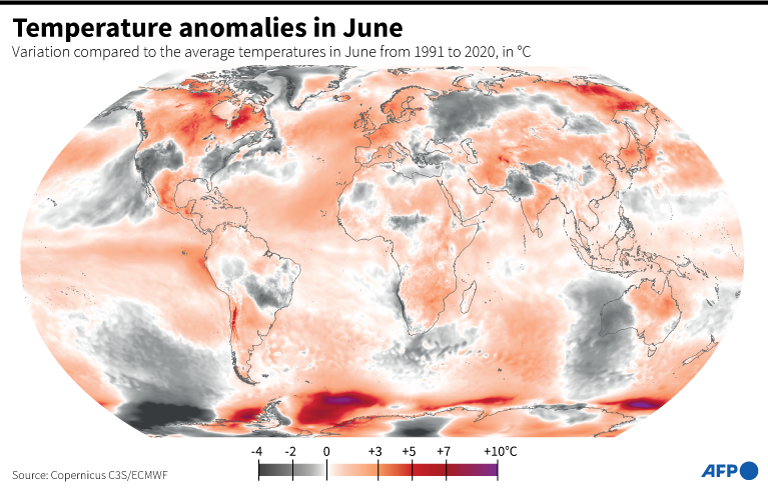
By Benjamin LEGENDRE
Agence France-Presse
PARIS, France (AFP) — The world saw its hottest June on record last month, the EU’s climate monitoring service said Thursday, as climate change and the El Niño weather pattern looked likely to drive another scorching northern summer.
The EU monitor Copernicus also said preliminary data showed Tuesday was the hottest day ever recorded — beating the record set only the day before.
It’s the latest in a series of records halfway through a year that has already seen a drought in Spain and fierce heat waves in China as well the United States.
“The month was the warmest June globally at just over 0.5 degrees Celsius above the 1991-2020 average, exceeding June 2019 -– the previous record -– by a substantial margin,” the EU monitor said in a statement from its C3S climate unit.
Temperatures reached June records across northwest Europe while parts of Canada, the United States, Mexico, Asia and eastern Australia “were significantly warmer than normal”, Copernicus noted.
On the other hand it was cooler than normal in western Australia, the western United States and western Russia, it said.
UN Secretary General Antonio Guterres said “the situation we are witnessing now is the demonstration that climate change is out of control”.
He reiterated his wish that “developed countries can get to net zero emissions as close as possible to 2040 and the emerging economies as close as possible to 2050”.
– ‘Hottest day ever’ –
The tumbling records reflect the impact of global warming driven by greenhouse gases released from human activity.
Copernicus told AFP preliminary data showed a global average temperature of 17.03 C on Tuesday, beating another record of 16.88 C already set on Monday.
For June, Copernicus noted that sea surface temperatures were higher globally than any previous June on record, with “extreme marine heat waves” around Ireland, Britain and the Baltic.
Antarctic sea ice reached its lowest extent for June since satellite observations began, at 17 percent below average.
C3S scientist Julien Nicolas told AFP the June record was driven largely by “very warm ocean surface temperatures” in the Pacific and Atlantic due to El Nino, a periodic warming phenomenon.
Marine heatwaves struck the Atlantic and low winds meant the warm surface did not mix with colder water deeper down.
“On top of that is this warming trend of the ocean absorbing 90 percent of heat released by human activity,” he added.
The global temperature was 0.53 C above the 30-year average at an average of 16.51C (61.72 degrees Fahrenheit), he calculated.
“June 2023 is way above the others. This is the kind of anomaly we are not used to,” Nicolas said.
Petteri Taalas, secretary-general of the UN’s World Meteorological Organization, warned on Monday that El Nino “will greatly increase the likelihood of breaking temperature records and triggering more extreme heat in many parts of the world and in the ocean.”
He urged governments “to mobilise preparations to limit the impacts on our health, our ecosystems and our economies.”
– Deadly heat waves –
El Nino is a naturally occurring pattern that drives increased heat worldwide, as well as drought in some parts of the world and heavy rains elsewhere.
In addition, human activity –- mainly the burning of fossil fuels -– emits roughly 40 billion tonnes of planet-warming CO2 into the atmosphere every year.
As well as withering crops, melting glaciers and raising the risk of wildfires, higher-than-normal temperatures also cause health problems ranging from heatstroke and dehydration to cardiovascular stress.
In the United States, local officials said last week that at least 13 people died from an extreme heatwave in Texas and Louisiana.
China issued its highest-level heat alert for northern parts of the country as Beijing baked in temperatures around 40 degrees Celsius.
After a record hot June in Britain, water use restrictions were imposed in parts of southeastern England, and Scotland put regions on water scarcity alert.
The world has warmed an average of nearly 1.2 C since the mid-1800s, unleashing extreme weather including more intense heatwaves, more severe droughts in some areas and storms made fiercer by rising seas.
© Agence France-Presse







